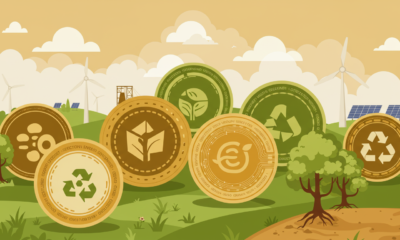One of the things that we wanted to talk about at Blue and Green Tomorrow this week is how law firms are starting to embrace sustainability in their everyday operations. We have already talked about some of the issues around sustainability in business.
It is fascinating to see an industry once known for paper-heavy processes and energy-intensive offices now exploring ways to go green. You can already see this change in how they approach client relations and internal policies. There are growing expectations from both employees and clients for firms to reduce their environmental impact. We covered some of this in a previous article on DWI lawyers and how they are going green.
A report from The Global Legal Post revealed that more than a third of top law firms are still contributing to the climate crisis by advising some of the world’s biggest polluters, and many are now trying to redeem themselves from that reputation. “This is a moment of truth for the legal industry,” stated Aidan Bassett, LSCA’s national student leadership committee research co-chair. “The business case for clean energy has never been stronger, and the moral courage of major firms has never been so in question.” You might notice how this acknowledgment has motivated many firms to reconsider the kinds of clients they represent. Keep reading to learn more.
The Rise of Sustainability in Legal Practic
A study from the Harvard Law School Center on the Legal Profession found that by June 2021, more than 40 percent of major U.S. law firms had practices centered on ESG. You can see that environmental, social, and governance matters are no longer a niche area of expertise but a growing part of mainstream legal work. There are entire departments focused on advising clients about sustainable compliance and ethical investing. It is becoming a competitive advantage for firms to demonstrate leadership in these areas.
Business Dasher reports that 82 percent of businesses worldwide are now reporting on sustainability, which directly influences how their legal advisors operate. You might expect law firms to adapt quickly to meet these new standards. It is not only about aligning with client expectations but also about showing authenticity in corporate responsibility. There are more firms now setting internal emissions goals and reporting on progress.
You can also see law firms embracing technology to support sustainability goals. There are now digital filing systems that have replaced massive physical archives once consuming entire floors of office space. It is clear that paperless workflows save resources and improve long-term document access. You can tell this trend helps firms cut costs while meeting eco-friendly commitments.
Some firms are also focusing on their physical spaces by adopting green building standards and energy-efficient offices. You will find that many have moved to LEED-certified buildings or retrofitted older ones to reduce energy waste. There are offices where natural lighting and renewable materials have replaced traditional designs. It is a visible statement of environmental awareness that clients and staff appreciate.
There are other ways firms show responsibility, such as encouraging remote or hybrid work. You can see that fewer daily commutes reduce carbon emissions significantly. It is a change that also appeals to employees who want a balance between work and sustainability. There are studies showing that this hybrid model benefits morale while cutting environmental costs.
It is important to recognize that many law firms are now using pro bono resources to support climate litigation and environmental justice. You can find lawyers assisting nonprofit groups or small communities affected by environmental harm. There are entire projects devoted to protecting natural resources and promoting fair environmental regulation. You can tell this growing involvement reflects a moral shift within the profession.
You can notice that these changes are also attracting new talent to the field. There are young attorneys who seek to work at firms with strong sustainability ethics. It is often part of recruitment pitches where firms highlight their carbon neutrality goals or social impact reports. You can sense that environmental responsibility has become a key measure of prestige in modern legal careers.
The legal sector is often seen as paper-heavy, traditional, and resistant to change. Yet law firms, like all businesses, face pressure to reduce their environmental impact, and rising energy costs, client expectations, and stricter regulations all make sustainability more compelling for law firms to satisfy.
Small changes in how firms operate can make a real difference. From rethinking office energy use to cutting back on travel, there are many ways to take action. Read on to consider some of the practical steps law firms can take to lower their environmental footprint and to explore sustainable solutions for your practice.
Cutting Back on Paper Use
Law firms are well known for their reliance on paper. Case files, contracts, and client letters can often fill up entire rooms, but this habit is costly for both budgets and the environment. Printing thousands of pages each year increases waste and requires more storage, but moving towards digital processes can solve much of this.
Tools for document management for law firms make it easier to store, search, and share files without relying on paper copies. Scanning existing records and storing them securely online reduces clutter, and encouraging staff to print only when necessary can help, too. Courts and regulators are also accepting more digital submissions, making for a much smoother transition.
Cutting back on paper does not mean cutting corners. Instead, it creates faster and more efficient workflows while reducing waste. Over time, the savings in paper, ink, and storage space add up, and the environmental benefits are hugely apparent.
Smarter Office Energy Use
Offices consume a large amount of energy, and law firms are no exception. Long working hours mean lights, computers, and heating often run well beyond normal business times. One step firms can take is to upgrade to energy-efficient equipment.
LED lighting and modern heating systems use far less power. Encouraging staff to switch off computers and lights when not in use also helps. Even simple changes, like setting printers to standby mode or lowering thermostat levels, can cut energy bills. Larger firms could consider renewable energy sources, such as solar panels on office buildings. For smaller practices, switching to a green energy supplier is another way to reduce reliance on fossil fuels. Remote working, when possible, also decreases office energy demand.
Smarter energy use reduces environmental impact and also shows clients and employees that the firm is taking responsibility.
Reducing Business Travel
Law firms traditionally rely on face-to-face meetings. Whether with clients, colleagues, or in court, travel has long been part of the profession. But constant flights and car journeys come with a heavy carbon cost.
The rise of secure video conferencing is quickly making travel less essential. Meetings that once required a long train journey can now be handled online in minutes. Court systems are increasingly accepting virtual hearings, too.
Encouraging staff to use public transport or cycle when travel is unavoidable also makes a difference. Some firms have begun offering incentives, such as covering the cost of travel cards or providing cycle-to-work schemes. Cutting back on business travel in these ways saves time, reduces costs, and lowers emissions.
While personal contact remains important in law, it does not always require a physical presence. The key is finding the balance between tradition and sustainability.
Sustainable Office Design and Supplies
The design of an office space influences how sustainable it can be. Older buildings may not have good insulation or energy-efficient windows, but improvements can still be made, including adding better insulation, using recycled materials for renovations, and investing in efficient heating systems.
Choosing sustainable office furniture from responsible sources is another way to cut environmental impact. Many suppliers now offer desks and chairs made from recycled or responsibly sourced materials. Everyday office supplies, from pens to cleaning products, can also be chosen with special care: opting for recycled paper, refillable pens, and non-toxic cleaning solutions is a fantastic way to support greener operations. Also, plants in the office not only improve air quality but also create a calmer environment for staff.
A sustainable office design is about making thoughtful choices that last longer and waste less, producing environmental benefits both now and long into the future.
It is encouraging to see law firms taking real steps toward sustainability, both internally and through the services they provide. You can understand that this shift represents a broader cultural move within the legal community toward accountability and purpose-driven work. There are now more examples each year of firms integrating environmental values into everything from daily operations to client advisement.
You might say this eco-conscious transformation reflects how professional industries evolve in response to global challenges. It is not just about reputation or client demand—it represents a genuine effort to match legal integrity with environmental responsibility. There are strong signs that the green movement within law is not temporary but part of a lasting change.


 Environment10 months ago
Environment10 months agoAre Polymer Banknotes: an Eco-Friendly Trend or a Groundswell?

 Environment11 months ago
Environment11 months agoEco-Friendly Home Improvements: Top 7 Upgrades for 2025

 Features9 months ago
Features9 months agoEco-Friendly Cryptocurrencies: Sustainable Investment Choices

 Features10 months ago
Features10 months agoEco-Friendly Crypto Traders Must Find the Right Exchange































